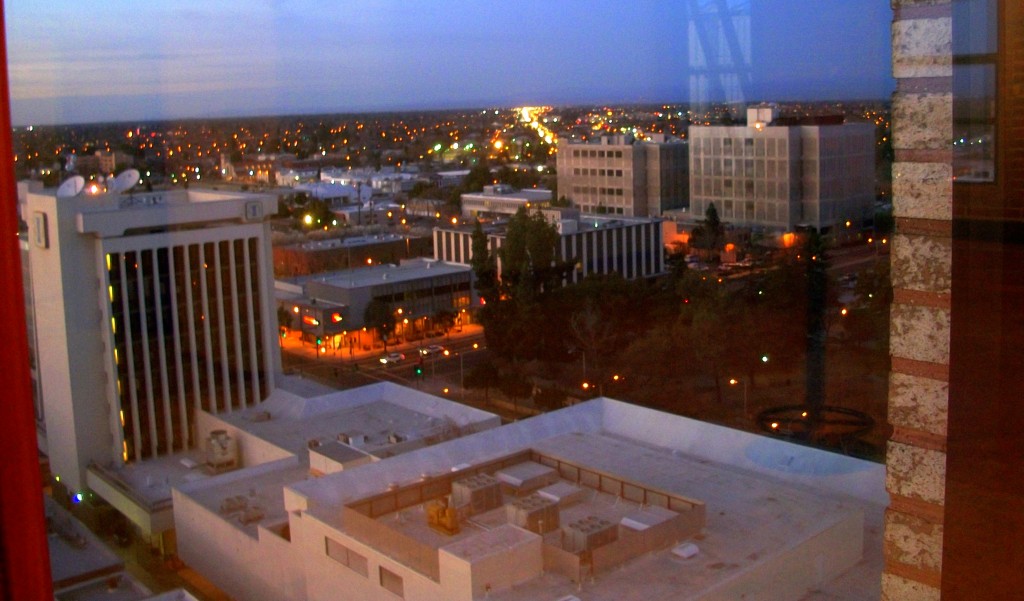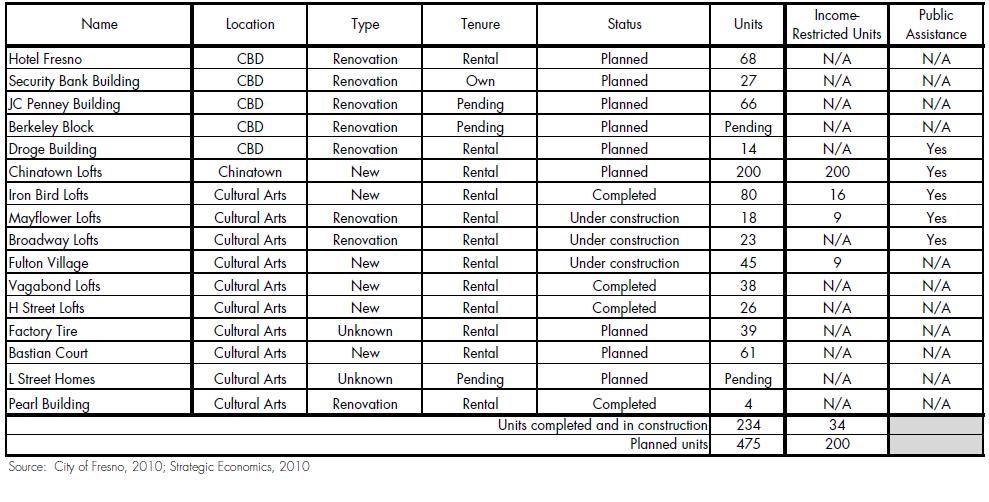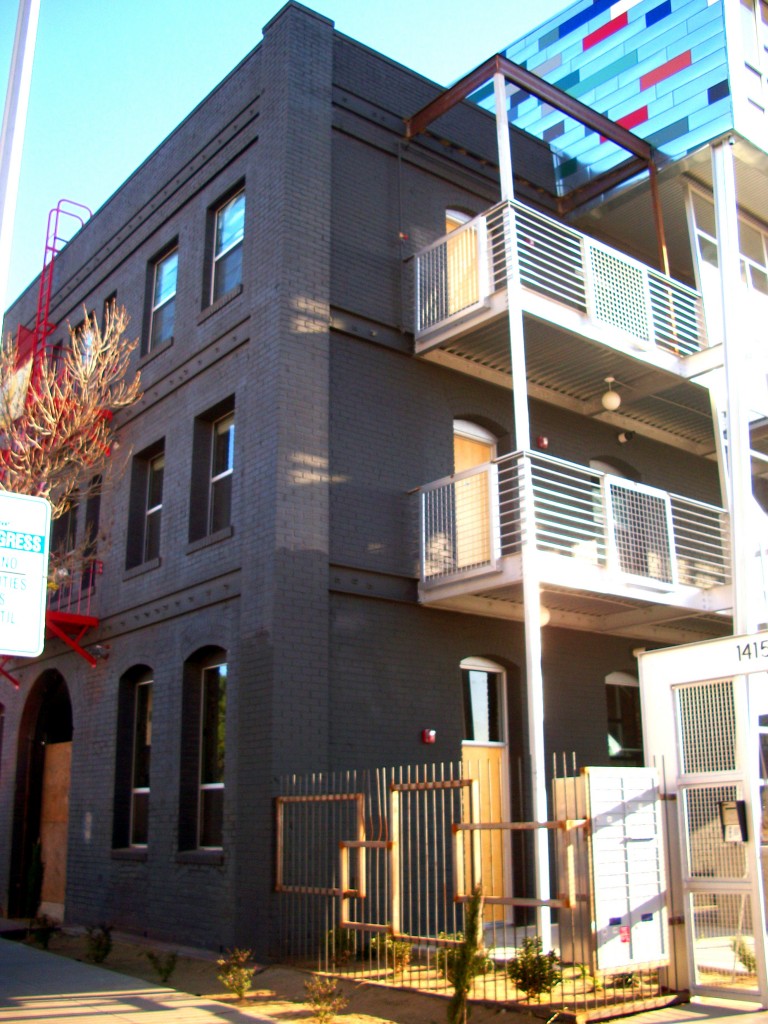Downtown Fresno Housing Market Analysis

View of Downtown Fresno from a loft in the Pacific Southwest Building. You can see the cars on Fwy 41, driving to and from the suburbs. The new owner plans to renovate three stories into lofts within three years.
Strategics Economics (SE) put together a market analysis report of Downtown Fresno. This post serves a summary of SE’s findings for the housing market in Downtown Fresno and its potential.
CURRENT DEMAND
The majority of housing, in Downtown Fresno, is multi-family. Most existing houses in Downtown were built before WWI when residential development favored multi-family units. Recent development in the Cultural Arts District (northwest portion of Downtown) has added to this inventory. The rental market has improved at a faster rate than the housing market, in Fresno. The demand for dense housing is expected to increase its share in the residential market, in the long run. Downtown Fresno has the potential to capture a large amount of this future development.
SALES ACTIVITY
Housing prices in Downtown are the least competitive in the City. The average sales price of a residential unit in Downtown and its surrounding neighborhoods is estimated to range from $55 to $75 per square foot. The citywide average sales price typically ranges $85 to $100 per square foot and around $125 per square foot and beyond for high-quality housing. You would think that a comparatively low price would encourage competive buying among real estate investors. However, houses are typically on the market longer than any other area.
DEVELOPMENT ACTIVITY

Recent residential development activity in Downtown Fresno. Since 2010, the Mayflower lofts, Broadway Lofts and Fulton Village have been completed. The JC Penny Building is in the process of changing ownership. It is unknown, to me, what the new owner plans to do.
Houses are now being built from the ground up or from rehabilitated industrial buildings. The Cultural Arts District has seen the most development in Downtown Fresno in the past few years.
About six large historic buildings on the Fulton Mall have been purchased with the intentions to renovate the upper floors into residential lofts. In order for these buildings to allow people to live there, the buildings need to be up to code. This will require a lot of investment. Almost all of these plans are at a standstill, as a result.
Earlier this year, the Redevelopment Agency was forced to close its doors. The Agency was responsible for handing developers public money. The Agency is still obligated to fulfill their remaining contracts. However, it is uncertain if the area will attract enough private money to develop more residential units.
LACK OF PROFIT
Most, if not all, of recent development provide affordable housing. Developers were encouraged to reserve units for low-income housing. This is how they received public money from the Housing Authority and the former Redevelopment Agency.
Downtown developers have been required to invest a lot of money to improve underground infrastructure and adjacent streets. Pair that with low market values and it’s not surprising that new development has not been profitable. The lack of profit makes private development without subsidies unappealing.
There is still continued interest in developing in Downtown. This is a good sign and will provide a lot of opportunities for businesses, especially for businesses. The end of this post goes more into detail about potential investments.
CAN DOWNTOWN ATTRACT ENOUGH PRIVATE MONEY?

Mayflower Lofts located on the corner of Tuolumne and Broadway (outside the north end of the Fulton Mall). Rehabbing existing buildings, like this one, is the least expensive way to create residential units. It provides the developer the opportunity to mix modern design with historic features.
It doesn’t make economic sense, right now, to develop multi-family units with only private money. Constructing an apartment building requires a high upfront cost. Land has historically been inexpensive in Fresno. There is plenty of undeveloped land and we face very little geographic barriers and policies that prevent us from sprawling out. This makes single-family homes more profitable and more in demand. The 2035 General Plan - expected to be adopted soon - focuses on infill development. If the City carries out the vision, the market will favor high-density housing
For development in Downtown to be profitable, revenue is needed to be increased to make a profit. Rents in Downtown have not increased enough to build without public money. Construction of residential units might become more feasible when economic activity improves and Downtown sees the rehabilitation and construction of complimentary development.
FUTURE DEMAND

Expected market demand for dense housing from 2010 to 2035. The 2035 General Plan, expected to be adopted soon, will support infill development and will severely limit the expansion of the City's boundaries.
SE predicts that 58,000 compacted units will be developed between 2010 and 2035. This will account for 40% of the City’s housing growth. The amount of units we will see in Downtown depends on government involvement. If the government only pumps money for project-based enchancements and subsidies than we can expect to see 4,000 units (145 units per year). If the government makes infrastructure upgrades, improves bicycle/pedestrian access and amenities, makes Downtown better connected, and hands out more project subsidies than we can expect to see 7,000 units (249 units per year). Investment in public infrastructure serves as a “kick start” for private development.
INVESTMENT OPPORTUNITIES

Iron Bird Lofts located near the corner of Fulton and Divisadero. The development is mixed-use. There are offices and a cafe on the ground floor and residential on the upper floors and in back. This arrangement takes care of the long-debated question: do businesses or residents come first? This is a glimpse of what new development in Downtown will look like.
There are several amenities missing in Downtown. Developers find it difficult to justify the price of living in Downtown. There are several opportunities for businesses and real estate investors. The following is a list of places the area is missing*:
- Businesses that supply the daily needs of residents: The best example is a grocery store. The closest grocery stores to the Iron Bird Lofts are Fresh & Easy and Food Maxx. Food Maxx is a mile and a half west of the development and Fresh & Easy is a mile and a half southeast. This isn’t too far, but there are a few barriers that make it difficult for residents to go to the grocery store. You have to travel across the railroad tracks and pass the Highway 99 overpass to get to Food Maxx. This is inefficient if you are riding a bike. One resident drives on the freeway to efficiently get to Fresh & Easy. There needs to be an affordable grocery store within a half mile or a mile radius of new developments. Warehouses, abundant in the area, might be best suited for a grocery store.
- Businesses that cater to young professionals: The area is geared towards young and single professionals. Residents have to drive about 15 minutes for the nearest dry cleaners or gym. The motive for someone to live in a downtown is to be in close proximity of almost everything a city offers.
- Quick-service restaurants: I don’t mean chain fast-food restaurants, but places residents can quickly eat at for dinner at after work. More restaurants are needed to be open during the evening and on the weekends. Fulton 55, a concert venue, is making the place more active after work hours.
- Community garden: The City has been granted $2.5 million to create a park in the Cultural Arts District. It is expected to be located at 1613 Fulton Street. The park will most likely have a tot lot, picnic tables, and a sports court. The City is limited in funds to create and maintaining more open spaces. The Cultural Arts District has the best potential for a community garden. The private sector can most efficiently provide for a community garden. An owner of a vacant lot can charge rent for a small plot. There is little maintenance for the owner, since renters are responsible for any improvements on the land. A private property owner can set up physical barriers to prevent trespassing.
*None of this is mentioned in the market report. I wanted to contribute my personal opinion based on my observations and my discussions with Downtown residents. Please add your opinion and experiences in the comments.
___
Read more about the real estate market in Downtown Fresno:
___
Have a lovely day in Fresno!
Veronica Stumpf, Co-Broker
Stumpf and Company Commercial Real Estate
DRE Lic. #01906952


Veronica, Who is building the housing units one block south of Ventura on G Street? Are there any private investors involved there?
I think that would be the Chinatown Lofts. I found information on this Web site: http://www.fresnorda.com/index.php?rda=portfolio&n=areas&p=4
Fresno Historic Chinatown, LLC are the developers. They’ve received over $4 million in public money, so far. I’m not sure how much the project has progressed since 2009. Nor do I know if there are any private developers.
I will ask around!
I received more information from Craig Scharton. The project is on hold. It was challenged by Danish Creamery, a nearby plant. Their stated reason is they didn’t want people living near the plant. They use a gas that could be harmful to future residents if it leaked. They also didn’t want residents to file a nuisance report on the plant.
In my opinion, the best housing downtown is either of the gated communities at Huntington and R Street. It is inexpensive and safe and close to all the good stuff, like Fresh and Easy, public library, Selland Arena, Amtrak, Office Depot, Salvation Army and a handful of restaurants and bars. Plus it’s convenient to all the highways, so we can get to any part of town with ease. We’ve been there 2 years and are so happy with the location.
I concur with this. Have lived there over 3 years myself and Fresh and Easy has taken a lot of my money. We often walk to the library (3 minutes) and Selland for hockey games (5 minutes). I enjoy the proximity to the 180/41 which allows you to get to clovis or river park in less than 10 minutes. It seems like many of these articles and blogs always mention the various lofts going up (which are awesome in their own right) but fail to mention the Huntington and R residencies. And the biggest perk is that they are condos and can be bought. I am an owner and between mortage and HOA fees I pay about $610/month. The extra money in rent savings allows me to waste it at F and E daily.
Wow! I see the Huntington & R condos when I visit the Small Business Administration (SBA). They do look very lovely, but I wasn’t sure if they were available to purchase or to rent. Nor have I come across any information online. The location and price of the residences seem very favorable. The Cultural Arts District is still lacking and the relatively high rent price doesn’t quite match up with what you are getting….yet.
Fresh & Easy wouldn’t be my first choice to shop for food. They do sell great stuff, but their selection is minimal and I’m not too fond of the prices. It would be a great opportunity for a local grocery store to locate to Downtown. Less competition than North Fresno.
Your style is really unique in comparison to other folks I’ve read stuff from. Thank you for posting when you have the opportunity, Guess I’ll just bookmark this web site.